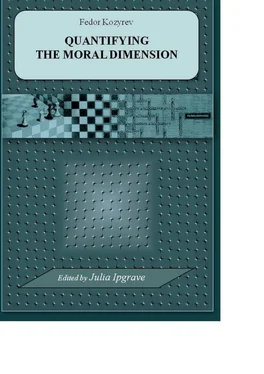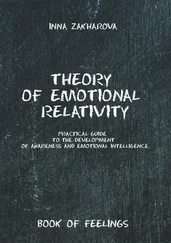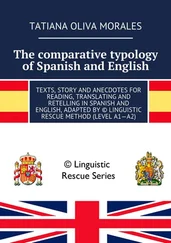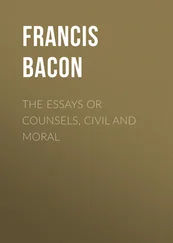Fedor Kozyrev - Quantifying the Moral Dimension. New steps in the implementation of Kohlberg’s method and theory
Здесь есть возможность читать онлайн «Fedor Kozyrev - Quantifying the Moral Dimension. New steps in the implementation of Kohlberg’s method and theory» — ознакомительный отрывок электронной книги совершенно бесплатно, а после прочтения отрывка купить полную версию. В некоторых случаях можно слушать аудио, скачать через торрент в формате fb2 и присутствует краткое содержание. ISBN: , Жанр: Прочая научная литература, psy_generic, на английском языке. Описание произведения, (предисловие) а так же отзывы посетителей доступны на портале библиотеки ЛибКат.
- Название:Quantifying the Moral Dimension. New steps in the implementation of Kohlberg’s method and theory
- Автор:
- Жанр:
- Год:неизвестен
- ISBN:9785005139412
- Рейтинг книги:5 / 5. Голосов: 1
-
Избранное:Добавить в избранное
- Отзывы:
-
Ваша оценка:
- 100
- 1
- 2
- 3
- 4
- 5
Quantifying the Moral Dimension. New steps in the implementation of Kohlberg’s method and theory: краткое содержание, описание и аннотация
Предлагаем к чтению аннотацию, описание, краткое содержание или предисловие (зависит от того, что написал сам автор книги «Quantifying the Moral Dimension. New steps in the implementation of Kohlberg’s method and theory»). Если вы не нашли необходимую информацию о книге — напишите в комментариях, мы постараемся отыскать её.
Quantifying the Moral Dimension. New steps in the implementation of Kohlberg’s method and theory — читать онлайн ознакомительный отрывок
Ниже представлен текст книги, разбитый по страницам. Система сохранения места последней прочитанной страницы, позволяет с удобством читать онлайн бесплатно книгу «Quantifying the Moral Dimension. New steps in the implementation of Kohlberg’s method and theory», без необходимости каждый раз заново искать на чём Вы остановились. Поставьте закладку, и сможете в любой момент перейти на страницу, на которой закончили чтение.
Интервал:
Закладка:
Constructivism bases its strategy on a humanities-style determination to overcome the toxic consequences of reductionism. But unlike other humanities movements it tries to achieve this aim not at the expense of achievements in computer techniques, mathematical statistics and analysis but through their more intensive usage. The binding pedantry of old science is overpowered by means of reconsidering the role and the potency of the methodological equipment of exact sciences. No more is it an idol on the pedestal of the infallibility of positive knowledge but an instrument in the palette of means for the researcher to use creatively..
Constructivist devotion to quantitative methods should be regarded neither as a result of compromise between the humanities and natural sciences nor as a return to ideals of positivism inspired by (really existing) dissatisfaction with the effectiveness of methodology of the humanities. Rather it should be regarded as a response to the challenges of the information era. The mass of information, the ongoing specialisation of scientific knowledge, the growing complexity of methods create a new form of esotericism, based on the impossibility for a mere mortal to understand the way of obtaining published data, or even more so to evaluate the reliability and consistency of their conclusions. The choice is either to capitulate to the power of scientific corporations and their sponsors or to improve abilities to resist manipulation through the methodological training of consumers of knowledge and developing institutions of independent expertise.
Constructivism occupies an active position in this respect. It is ready to struggle for scientific uprightness with mathematically formulated facts to hand, armed with the achievements of post-positivist epistemology and emancipated from the illusion of scientific impartiality, tempered with the skepticism of Popper’s fallibility and relativity. But in order to win in this way its methodological level of expertise must exceed that of scientific «scribes and Pharisees» who still insist that the researcher is for the method just as man is for the Sabbath and not vice versa. Contemporary scientific creativeness should confront the methodological narrowness of the former school not with voluntarism but with methodological sophistication that includes skills in different techniques and more adequate understanding of the role of personality in producing scientific knowledge. It seems as though constructivism more than any other scientific movement is able to show that the historically determined rise of the influence of the humanities in scientific knowledge does not necessarily mean the refusal of the positivists’ tool, but rather a more qualified usage of it. This may be the historical mission of constructivism.
So, the constructivist programmes of psychological and pedagogical diagnostics include the following principles:
– targeting the detection of hidden psychic structures (constructs) responsible for the interpretation of reality;
– acknowledgment of the dynamic nature and socio-cultural conditionality of constructs, emphasis on the social factors of their formation, including the narrative identity of the subject;
– interactive and flexible research strategies, improvising with the available set of methods and step by step correction of programmes in accordance with research results;
– contextual interpretation of phenomena under study, aspiration for semantic homogeneity of contents and means of expression;
– holistic devotion to the priority of the whole over the sum of parts, intention to represent the psyche in forms of integral patterns;
– «digital’, or combinative way of building and presenting patterns from discrete units which allows an analytical dismantling;
– wide application of psychometric technologies for quantifying selected parameters in universal and ipsative scales;
– using existent and developing new methods of multidimensional statistics and analysis for more effective operation with clusters and data sets;
– focus on the phenomena of coherency, coordination, hierarchical subordination and functional specialisation of psychic structures as a source of self-organisation and development of personality.
2. ONYX: A new moral judgment test
2.1. Historical background
ONYX is a transliteration of a Russian acronym. The full name of the test reads like «Assessment of moral discernment and coherence of judgment». The meaning would be more properly represented if the word «moral’ were relocated and placed before the word «judgment’, but this would make the abbreviation unpronounceable in Russian. What is more, the name of the stone would be lost in this case, and it would be a pity because onyx is a good symbol for the test. Like any stone our test is a solid cohesive thing but besides that it has a striped structure, just like onyx.
The idea of quantifying and measuring the moral qualities of a person cannot but cause an instinctive repulsion. Yet science has a history of breaking its way through the cordons of intuitive prejudices and instinctive protests. Anatomy is a good example showing how the once blasphemous practice of studying the human body gave new opportunities for healing. Is it impossible that results of the «anatomy of the soul» will bring forth good fruits in the future for pedagogical practice? Of course, the latter case is much more complicated not least because it is much more difficult to come to agreement about what is to be measured. A unifying theory is necessary in this case not only at the stage of the interpretation of data but at the very beginning while designing the approach. Differences of concepts about light or gravity were not obstacles to using scales or differentiating stars according to their luminosity because the ability to distinguish heavy from light and dark from bright lies in the commonality of sensual perception. Moral properties are not generally valid in the same sense.
Attempts to build a general theory of morality and establish common criteria of what it is to be moral have a long history. Of special interest in this respect is Socrates’ reasoning presented in Plato’s dialogue «Hippias Minor». In this dialogue Socrates asks his collocutor to think what is more immoral – to behave badly when you know what is right and what is wrong or to do it when you don’t know. Hippias, as the majority of us would, answers immediately:
– And how, Socrates, can those who intentionally err, and voluntarily and designedly commit iniquities, be better than those who err and do wrong involuntarily?
But this answer does not satisfy Socrates:
– And now I cannot agree in what you are saying, but I strongly disagree <���….> and my opinion, Hippias, is the very contrary of what you are saying. For I maintain that those who hurt or injure mankind, and speak falsely and deceive, and err voluntarily, are better far than those who do wrong involuntarily.
Argumentation for this shocking conclusion is built on a sequence of analogies. Who is the better musician: the one who produces cacophony voluntarily or the one who can’t play properly? Who is the better athlete: the one who pretends that he has a pain in his knee and doesn’t want to run fast or the one who can’t run fast? Socrates does not find a reason why we should make an exception for moral actions in this sequence. And Hippias does not find contra-arguments except for a mere appeal to moral feeling:
– O, Socrates, it would be a monstrous thing to say that those who do wrong voluntarily are better than those who do wrong involuntarily!
– Socr.: And yet that appears to be the only inference.
Probably it could be regarded as a mere sophistic exercise, more so as Socrates confesses finally that he does not agree with himself in his conclusion. But in the history of pedagogy the nontrivial line of reasoning presented by Socrates in this dialogue appears from time to time among the thoughts of the most venerable scholars. Herbart in his «Textbook in Psychology» ( Lehrbuch der Psychologie ) claims that ethics attains its strength not in appeals for good behaviour addressed to human will but in the clarity and cohesion of moral vision or insight which constitutes a special competence. He called this competence moral judgment (or moral sense) and insisted time and again that this competence is not innate but is to be developed and trained by means of education. Being a variant of aesthetic judgment, this competence is more related to ideas of beautiful and ugly than to that of due and improper, and accordingly, the best means for its development are to be found not in logic and law but in the field of humanities. In his earlier work «The Science of Education and the Aesthetic Revelation of the World» he particularly focuses on this connection between ethics and aesthetics and on the role of humanities in moral education. The quality of moral judgment in complex situations depends on how rich, balanced, and comprehensive personal perceptions are. And humanities widening the horizon of a learner are able to prevent at the same time the one-sidedness of this judgment. Furthermore in Herbart’s system «the one-sided person approximates the egoist, even when he will not notice it himself, because he relates everything to the small circle of his own life and thought» (Meijer 2006). We have here a clear antecedent of Piaget’s theory that relates the moral development of a person to a process of successive decentration of ego and also a historical bridge from Socrates’ doubts about the morality of the morally ignorant to those modern scholars who base their evaluations of morality on concepts of moral competences.
Читать дальшеИнтервал:
Закладка:
Похожие книги на «Quantifying the Moral Dimension. New steps in the implementation of Kohlberg’s method and theory»
Представляем Вашему вниманию похожие книги на «Quantifying the Moral Dimension. New steps in the implementation of Kohlberg’s method and theory» списком для выбора. Мы отобрали схожую по названию и смыслу литературу в надежде предоставить читателям больше вариантов отыскать новые, интересные, ещё непрочитанные произведения.
Обсуждение, отзывы о книге «Quantifying the Moral Dimension. New steps in the implementation of Kohlberg’s method and theory» и просто собственные мнения читателей. Оставьте ваши комментарии, напишите, что Вы думаете о произведении, его смысле или главных героях. Укажите что конкретно понравилось, а что нет, и почему Вы так считаете.












